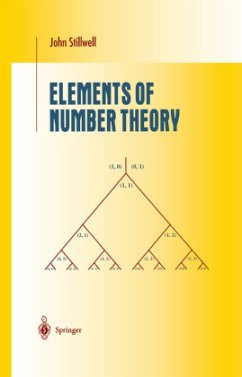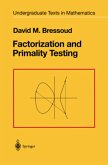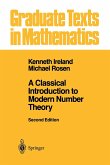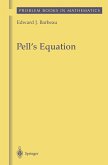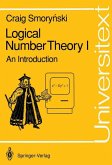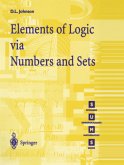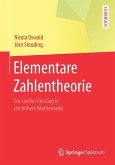Solutions of equations in integers is the central problem of number theory and is the focus of this book. The amount of material is suitable for a one-semester course. The author has tried to avoid the ad hoc proofs in favor of unifying ideas that work in many situations. There are exercises at the end of almost every section, so that each new idea or proof receives immediate reinforcement.
This book is intended to complement my Elements oi Algebra, and it is similarly motivated by the problem of solving polynomial equations. However, it is independent of the algebra book, and probably easier. In Elements oi Algebra we sought solution by radicals, and this led to the concepts of fields and groups and their fusion in the celebrated theory of Galois. In the present book we seek integer solutions, and this leads to the concepts of rings and ideals which merge in the equally celebrated theory of ideals due to Kummer and Dedekind. Solving equations in integers is the central problem of number theory, so this book is truly a number theory book, with most of the results found in standard number theory courses. However, numbers are best understood through their algebraic structure, and the necessary algebraic concepts rings and ideals-have no better motivation than number theory. The first nontrivial examples of rings appear in the number theory of Euler and Gauss. The concept of ideal-today as routine in ring the ory as the concept of normal subgroup is in group theory-also emerged from number theory, and in quite heroic fashion. Faced with failure of unique prime factorization in the arithmetic of certain generalized "inte gers" , Kummer created in the 1840s a new kind of number to overcome the difficulty. He called them "ideal numbers" because he did not know exactly what they were, though he knew how they behaved.
This book is intended to complement my Elements oi Algebra, and it is similarly motivated by the problem of solving polynomial equations. However, it is independent of the algebra book, and probably easier. In Elements oi Algebra we sought solution by radicals, and this led to the concepts of fields and groups and their fusion in the celebrated theory of Galois. In the present book we seek integer solutions, and this leads to the concepts of rings and ideals which merge in the equally celebrated theory of ideals due to Kummer and Dedekind. Solving equations in integers is the central problem of number theory, so this book is truly a number theory book, with most of the results found in standard number theory courses. However, numbers are best understood through their algebraic structure, and the necessary algebraic concepts rings and ideals-have no better motivation than number theory. The first nontrivial examples of rings appear in the number theory of Euler and Gauss. The concept of ideal-today as routine in ring the ory as the concept of normal subgroup is in group theory-also emerged from number theory, and in quite heroic fashion. Faced with failure of unique prime factorization in the arithmetic of certain generalized "inte gers" , Kummer created in the 1840s a new kind of number to overcome the difficulty. He called them "ideal numbers" because he did not know exactly what they were, though he knew how they behaved.
From the reviews: "Solving equations in integers is the central problem of number theory, so this book is truly a number theory book, with most of the results found in standard number theory courses. ... The book is clearly written, well organized and is a very pleasurable reading: it is an excellent and very useful undergraduate textbook. However, thanks to the many examples and exercises, it is well suitable for independent study, as well." (Lászlo Megyesi, Acta Scientiarum Mathematicarum, Vol. 71, 2005) "In this carefully crafted undergraduate number theory text, Stillwell walks the reader through the main topics that belong in any introduction to number theory ... but he does so in a way that highlights the beguiling nature of number theory problems and keeps their rich history alive. ... This book has some additional features that will draw you to order it for your courses. ... Stillwell ... presents a compelling argument for studying the ancient and modern problems of number theory ... ." (Gwynneth G. H. Coogan, Mathematical Reviews, 2004 j) "A solid systematic introduction to (algebraic) number theory which is truly elementary in the sense that a bright young undergraduate could make rapid unaided progress through this book. ... There are lots of goodies in the sidelines and the attention to clarity of writing and to pedagogic care give it a high rank amongst competing texts. ... Stillwell's book makes a very positive contribution to the coherence of the subject, which adds ... to the satisfaction of studying it." (John Baylis, The Mathematical Gazette, Vol. 88 (512), 2004) "Stillwell has taken very careful aim at his target audience and hit them squarely between the eyes. ... the author has done a wonderful job of conveying his obvious love of the subject to the reader. ... The author ... covers basic classical number theory. ... Each chapter opens with a substantial preview stating the central concepts which are about to appear. ... In short, this book is a delight to read and is ideally suited to a beginning course in number theory." (Ralph H. Buchholz, The Australian Mathematical Society Gazette, Vol. 31 (1), 2004) "The book is a concise introduction to number theory and some related algebra, with an emphasis on solving equations in integers. ... The historical development has been followed where it helps to motivate the introduction of new concepts, but modern proofs have been used where they are simpler, more natural, or more interesting. ... Also, this is the only elementary number theory book that includes significant applications of ideal theory." (Zentralblatt für Didaktik der Mathematik, February, 2003) "The text would be suitable for the standard elementary number theory course. ... could serve as an introduction to algebraic number theory. ... has a number of unusual and attractive features. ... there is much in this book that would make it an appealing choice for a group of able mathematics majors. ... the book under review provides a valuable and original alternative to the many current texts on introductory number theory." (David W. Boyd, SIAM Review, Vol. 46 (2), 2004)

